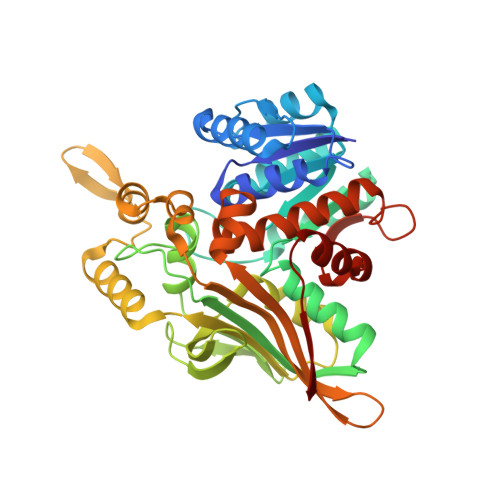Structural analysis of carboxyspermidine dehydrogenase from Helicobacter pylori.
Ko, K.Y., Park, S.C., Cho, S.Y., Yoon, S.I.(2022) Biochem Biophys Res Commun 635: 210-217
- PubMed: 36283333
- DOI: https://doi.org/10.1016/j.bbrc.2022.10.049
- Primary Citation of Related Structures:
8H4Z, 8H50, 8H52 - PubMed Abstract:
Spermidine is a cationic polyamine that plays key roles in diverse biological processes, including biofilm formation and cell viability in bacteria. In some human gastrointestinal bacteria, such as Helicobacter pylori and Campylobacter jejuni, spermidine is biosynthesized using carboxyspermidine dehydrogenase (CASDH) and carboxyspermidine decarboxylase through an alternative pathway rather than the classical pathway found in most bacteria and eukaryotes. CASDH condenses putrescine and aspartate β-semialdehyde into carboxyspermidine in an NADPH-dependent manner. Because structural information on CASDH is not available, the exact enzymatic mechanism of CASDH has not been elucidated. To reveal the structural features of CASDH required for cofactor and substrate recruitment, we determined the crystal structures of the H. pylori CASDH protein alone and in complex with NADP. CASDH consists of three domains (D1, D2, and D3) and assembles into a homodimer exclusively using the D3 domain. The CASDH structure harbors a dent between the D1 and D3 domains. The NADP cofactor is inserted into the interdomain dent and induces structural rearrangements in CASDH, including dent closure and local structural changes in the D1 and D3 domains. A comparative analysis suggests that the substrate of CASDH binds in a cavity near the nicotinamide moiety of NADPH for the condensation reaction.
- Division of Biomedical Convergence, College of Biomedical Science, Kangwon National University, Chuncheon, 24341, Republic of Korea.
Organizational Affiliation:

















